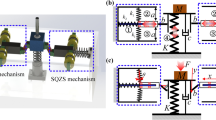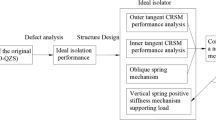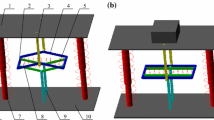Abstract
Quasi-zero stiffness (QZS) vibration isolators show great advantages in low frequency vibration isolation and often developed by compensating the negative stiffness of the bistable structure by linear spring. To overcome the limitation of the bistable property, this paper utilizes linear stiffness (linear spring) and nonlinear stiffness (repulsive magnets) respectively to compensate the general negative stiffness (rhombus structure), and realizes two types of vibration isolators, the QZS-L and QZS-N isolator. Static models are established to characterize the stiffness property and reveal two basic principles for realizing QZS. The realization of QZS in the QZS-L isolator requires large deformation, but it can be achieved under small deformation in the QZS-N system. Both the QZS-L isolator and QZS-N isolator have weak asymmetry in stiffness, which leads to bias in steady-state response. And the former has stronger asymmetry and greater bias. The adjustment method of the QZS-L and QZS-N isolators for different loads is also elaborated separately. A unified dynamic model is established and the displacement transmissibility is derived to evaluate the vibration isolation performance of the two system. The QZS-L isolator is a softening system with a left-shifted resonance peak, while the QZS-N behave as a hardening system with a right-shifted resonance peak. Both isolators have a low resonant frequency and a wide isolation frequency band. Moreover, the initial isolation frequency can become lower when adjusted for larger loads. Comprehensive comparisons and discussions of static characteristics, isolation band, and zero offset are instructive in designing low frequency vibration isolators.





















Similar content being viewed by others
Data availability
The data that support the findings of this study are available from the corresponding author [Wenming Zhang], upon reasonable request.
References
Gu, M., Du, X.: Experimental investigation of rain–wind-induced vibration of cables in cable-stayed bridges and its mitigation. J. Wind Eng. Ind. Aerodyn. 93, 79–95 (2005)
Zhang, T., Shi, D., Wang, Z., Zhang, P., Wang, S., Ding, X.: Vibration-based structural damage detection via phase-based motion estimation using convolutional neural networks. Mech. Syst. Signal Process. 178, 109320 (2022)
Ozsoy, M., Sims, N.D., Ozturk, E.: Robotically assisted active vibration control in milling: a feasibility study. Mech. Syst. Signal Process. 177, 109152 (2022)
Yun, H., Liu, L., Li, Q., Li, W., Tang, L.: Development of an isotropic Stewart platform for telescope secondary mirror. Mech. Syst. Signal Process. 127, 328–344 (2019)
Sun, Y., Gong, D., Zhou, J., Sun, W., Xia, Z.: Low frequency vibration control of railway vehicles based on a high static low dynamic stiffness dynamic vibration absorber. Sci. China Technol. Sci. 62, 60–69 (2019)
Wang, Q., Zhou, J., Xu, D., Ouyang, H.: Design and experimental investigation of ultra-low frequency vibration isolation during neonatal transport. Mech. Syst. Signal Process. 139, 106633 (2020)
Danh, L.T., Ahn, K.K.: Active pneumatic vibration isolation system using negative stiffness structures for a vehicle seat. J. Sound Vib. 333, 1245–1268 (2014)
Le, T.D., Ahn, K.K.: Experimental investigation of a vibration isolation system using negative stiffness structure. Int. J. Mech. Sci. 70, 99–112 (2013)
Abbasi, A., Nazari, F., Nataraj, C.: Adaptive modeling of vibrations and structural fatigue for analyzing crack propagation in a rotating system. J. Sound Vib. 541, 117276 (2022)
Kamesh, D., Pandiyan, R., Ghosal, A.: Modeling, design and analysis of low frequency platform for attenuating micro-vibration in spacecraft. J. Sound Vib. 329, 3431–3450 (2010)
Kamesh, D., Pandiyan, R., Ghosal, A.: Passive vibration isolation of reaction wheel disturbances using a low frequency flexible space platform. J. Sound Vib. 331, 1310–1330 (2012)
Ibrahim, R.A.: Recent advances in nonlinear passive vibration isolators. J. Sound Vib. 314, 371–452 (2008)
Xing, Z.-Y., Yang, X.-D.: A combined vibration isolation system with quasi-zero stiffness and dynamic vibration absorber. Int. J. Mech. Sci. 256, 108508 (2023)
Yu, C., Jiang, Q., Fu, Q., Yu, K., Zhang, J., Zhang, N.: The X-shaped structure with nonlinear positive stiffness compensation for low-frequency vibration isolation. Int. J. Mech. Sci. 259, 108598 (2023)
Carrella, A., Brennan, M.J., Kovacic, I., Waters, T.P.: On the force transmissibility of a vibration isolator with quasi-zero-stiffness. J. Sound Vib. 322, 707–717 (2009)
Carrella, A., Brennan, M.J., Waters, T.P.: Static analysis of a passive vibration isolator with quasi-zero-stiffness characteristic. J. Sound Vib. 301, 678–689 (2007)
Carrella, A., Brennan, M.J., Waters, T.P., Lopes, V.: Force and displacement transmissibility of a nonlinear isolator with high-static-low-dynamic-stiffness. Int. J. Mech. Sci. 55, 22–29 (2012)
Zhao, F., Ji, J., Ye, K., Luo, Q.: An innovative quasi-zero stiffness isolator with three pairs of oblique springs. Int. J. Mech. Sci. 192, 106093 (2021)
Zhao, F., Ji, J.C., Ye, K., Luo, Q.: Increase of quasi-zero stiffness region using two pairs of oblique springs. Mech. Syst. Signal Process. 144, 106975 (2020)
Brennan, M.J., Kovacic, I., Carrella, A., Waters, T.P.: On the jump-up and jump-down frequencies of the Duffing oscillator. J. Sound Vib. 318, 1250–1261 (2008)
Le, T.D., Nguyen, V.A.D.: Low frequency vibration isolator with adjustable configurative parameter. Int. J. Mech. Sci. 134, 224–233 (2017)
Yan, G., Zou, H.-X., Wang, S., Zhao, L.-C., Gao, Q.-H., Tan, T., Zhang, W.-M.: Large stroke quasi-zero stiffness vibration isolator using three-link mechanism. J. Sound Vib. 478, 115344 (2020)
Sun, X., Jing, X.: Multi-direction vibration isolation with quasi-zero stiffness by employing geometrical nonlinearity. Mech. Syst. Signal Process. 62–63, 149–163 (2015)
Li, M., Cheng, W., Xie, R.: A quasi-zero-stiffness vibration isolator using a cam mechanism with user-defined profile. Int. J. Mech. Sci. 189, 105938 (2021)
Yao, Y., Li, H., Li, Y., Wang, X.: Analytical and experimental investigation of a high-static-low-dynamic stiffness isolator with cam-roller-spring mechanism. Int. J. Mech. Sci. 186, 105888 (2020)
Zhou, J., Wang, X., Xu, D., Bishop, S.: Nonlinear dynamic characteristics of a quasi-zero stiffness vibration isolator with cam–roller–spring mechanisms. J. Sound Vib. 346, 53–69 (2015)
Zuo, S., Wang, D., Zhang, Y., Luo, Q.: Design and testing of a parabolic cam-roller quasi-zero-stiffness vibration isolator. Int. J. Mech. Sci. 220, 107146 (2022)
Kamaruzaman, N.A., Robertson, W.S.P., Ghayesh, M.H., Cazzolato, B.S., Zander, A.C.: Six degree of freedom quasi-zero stiffness magnetic spring with active control: theoretical analysis of passive versus active stability for vibration isolation. J. Sound Vib. 502, 116086 (2021)
Wu, M., Wu, J., Che, J., Gao, R., Chen, X., Li, X., Zeng, L., Jiang, W.: Analysis and experiment of a novel compact magnetic spring with high linear negative stiffness. Mech. Syst. Signal Process. 198, 110387 (2023)
Wu, W., Chen, X., Shan, Y.: Analysis and experiment of a vibration isolator using a novel magnetic spring with negative stiffness. J. Sound Vib. 333, 2958–2970 (2014)
Zheng, Y., Li, Q., Yan, B., Luo, Y., Zhang, X.: A Stewart isolator with high-static-low-dynamic stiffness struts based on negative stiffness magnetic springs. J. Sound Vib. 422, 390–408 (2018)
Ishida, S., Suzuki, K., Shimosaka, H.: Design and experimental analysis of origami-inspired vibration isolator with quasi-zero-stiffness characteristic. J. Vib. Acoust. 139, 051004 (2017)
Liu, S., Peng, G., Li, Z., Li, W., Sun, L.: Low-frequency vibration isolation via an elastic origami-inspired structure. Int. J. Mech. Sci. 260, 108622 (2023)
Ye, K., Ji, J.C.: An origami inspired quasi-zero stiffness vibration isolator using a novel truss-spring based stack Miura-ori structure. Mech. Syst. Signal Process. 165, 108383 (2022)
Han, H., Sorokin, V., Tang, L., Cao, D.: A nonlinear vibration isolator with quasi-zero-stiffness inspired by Miura-origami tube. Nonlinear Dyn. 105, 1313–1325 (2021)
Yan, G., Qi, W.-H., Shi, J.-W., Yan, H., Zou, H.-X., Zhao, L.-C., Wu, Z.-Y., Fang, X.-Y., Li, X.-Y., Zhang, W.-M.: Bionic paw-inspired structure for vibration isolation with novel nonlinear compensation mechanism. J. Sound Vib. 525, 116799 (2022)
Yan, G., Zou, H.-X., Wang, S., Zhao, L.-C., Wu, Z.-Y., Zhang, W.-M.: Bio-inspired vibration isolation: methodology and design. Appl. Mech. Rev. 73, 020801 (2021)
Yan, G., Zou, H.-X., Wang, S., Zhao, L.-C., Wu, Z.-Y., Zhang, W.-M.: Bio-inspired toe-like structure for low-frequency vibration isolation. Mech. Syst. Signal Process. 162, 108010 (2022)
Jing, X., Zhang, L., Feng, X., Sun, B., Li, Q.: A novel bio-inspired anti-vibration structure for operating hand-held jackhammers. Mech. Syst. Signal Process. 118, 317–339 (2019)
Sun, X., Qi, Z., Xu, J.: Vibration properties of a knee bio-inspired nonlinear isolation structure. Int. J. Non-Linear Mech. 147, 104245 (2022)
Sun, X., Xu, J., Wang, F., Zhang, S.: A novel isolation structure with flexible joints for impact and ultralow-frequency excitations. Int. J. Mech. Sci. 146–147, 366–376 (2018)
Wang, K., Zhou, J., Chang, Y., Ouyang, H., Xu, D., Yang, Y.: A nonlinear ultra-low-frequency vibration isolator with dual quasi-zero-stiffness mechanism. Nonlinear Dyn. 101, 755–773 (2020)
Ye, K., Ji, J.C., Brown, T.: Design of a quasi-zero stiffness isolation system for supporting different loads. J. Sound Vib. 471, 115198 (2020)
Dong, G., Zhang, X., Xie, S., Yan, B., Luo, Y.: Simulated and experimental studies on a high-static-low-dynamic stiffness isolator using magnetic negative stiffness spring. Mech. Syst. Signal Process. 86, 188–203 (2017)
Jiang, Y., Song, C., Ding, C., Xu, B.: Design of magnetic-air hybrid quasi-zero stiffness vibration isolation system. J. Sound Vib. 477, 115346 (2020)
Xu, D., Yu, Q., Zhou, J., Bishop, S.R.: Theoretical and experimental analyzes of a nonlinear magnetic vibration isolator with quasi-zero-stiffness characteristic. J. Sound Vib. 332, 3377–3389 (2013)
Yan, B., Ma, H., Zhao, C., Wu, C., Wang, K., Wang, P.: A vari-stiffness nonlinear isolator with magnetic effects: Theoretical modeling and experimental verification. Int. J. Mech. Sci. 148, 745–755 (2018)
Ma, H., Yan, B.: Nonlinear damping and mass effects of electromagnetic shunt damping for enhanced nonlinear vibration isolation. Mech. Syst. Signal Process. 146, 107010 (2021)
Ma, H., Yan, B., Zhang, L., Zheng, W., Wang, P., Wu, C.: On the design of nonlinear damping with electromagnetic shunt damping. Int. J. Mech. Sci. 175, 105513 (2020)
Yan, B., Ma, H., Zhang, L., Wu, C., Zhang, X.: Electromagnetic shunt damping for shock isolation of nonlinear vibration isolators. J. Sound Vib. 479, 115370 (2020)
Yan, B., Ma, H., Zheng, W., Jian, B., Wang, K., Wu, C.: Nonlinear Electromagnetic Shunt Damping for Nonlinear Vibration Isolators. IEEE/ASME Trans. Mechatron. 24, 1851–1860 (2019)
Yan, B., Wang, X., Ma, H., Lu, W., Li, Q.: Hybrid Time-Delayed Feedforward and Feedback Control of Lever-Type Quasi-Zero-Stiffness Vibration Isolators. IEEE Trans. Industr. Electron. 71, 2810–2819 (2024)
Huang, X., Chen, Y., Hua, H., Liu, X., Zhang, Z.: Shock isolation performance of a nonlinear isolator using Euler buckled beam as negative stiffness corrector: theoretical and experimental study. J. Sound Vib. 345, 178–196 (2015)
Huang, X., Liu, X., Sun, J., Zhang, Z., Hua, H.: Vibration isolation characteristics of a nonlinear isolator using Euler buckled beam as negative stiffness corrector: a theoretical and experimental study. J. Sound Vib. 333, 1132–1148 (2014)
Niu, M.-Q., Chen, L.-Q.: Nonlinear vibration isolation via a compliant mechanism and wire ropes. Nonlinear Dyn. 107, 1687–1702 (2022)
Chai, Y., Jing, X., Chao, X.: X-shaped mechanism based enhanced tunable QZS property for passive vibration isolation. Int. J. Mech. Sci. 218, 107077 (2022)
Yan, G., Wu, Z.-Y., Wei, X.-S., Wang, S., Zou, H.-X., Zhao, L.-C., Qi, W.-H., Zhang, W.-M.: Nonlinear compensation method for quasi-zero stiffness vibration isolation. J. Sound Vib. 523, 116743 (2021)
Jing, X., Chai, Y., Chao, X., Bian, J.: In-situ adjustable nonlinear passive stiffness using X-shaped mechanisms. Mech. Syst. Signal Process. 170, 108267 (2022)
Bian, J., Jing, X.: Analysis and design of a novel and compact X-structured vibration isolation mount (X-Mount) with wider quasi-zero-stiffness range. Nonlinear Dyn. 101, 2195–2222 (2020)
Qi, W.-H., Yan, G., Lu, J.-J., Yan, H., Shi, J.-W., Wei, X.-S., Wang, S., Zhang, W.-M.: Magnetically modulated sliding structure for low frequency vibration isolation. J. Sound Vib. 526, 116819 (2022)
Lu, J.-J., Yan, G., Qi, W.-H., Yan, H., Ma, J., Shi, J.-W., Wu, Z.-Y., Zhang, W.-M.: Sliding-boundary-constrained cantilever structure for vibration isolation via nonlinear stiffness modulation. Int. J. Mech. Sci. 235, 107733 (2022)
Zhao, T.-Y., Yan, G., Qi, W.-H., Lu, J.-J., Zhang, W.-M.: Magnetically modulated tetrahedral structure for low frequency vibration isolation with adjustable load capacity. Int. J. Mech. Sci. 251, 108335 (2023)
Dai, H., Jing, X., Sun, C., Wang, Y., Yue, X.: Accurate modeling and analysis of a bio-inspired isolation system: with application to on-orbit capture. Mech. Syst. Signal Process. 109, 111–133 (2018)
Dai, H., Jing, X., Wang, Y., Yue, X., Yuan, J.: Post-capture vibration suppression of spacecraft via a bio-inspired isolation system. Mech. Syst. Signal Process. 105, 214–240 (2018)
Sun, X., Jing, X., Xu, J., Cheng, L.: Vibration isolation via a scissor-like structured platform. J. Sound Vib. 333, 2404–2420 (2014)
Bednarek, M., Lewandowski, D., Polczyński, K., Awrejcewicz, J.: On the active damping of vibrations using electromagnetic spring. Mech. Based Des. Struct. Mach. 49, 1131–1144 (2020)
Pilipchuk, V.N., Polczyński, K., Bednarek, M., Awrejcewicz, J.: Guidance of the resonance energy flow in the mechanism of coupled magnetic pendulums. Mech. Mach. Theory 176, 105019 (2022)
Witkowski, K., Kudra, G., Skurativskyi, S., Wasilewski, G., Awrejcewicz, J.: Modeling and dynamics analysis of a forced two-degree-of-freedom mechanical oscillator with magnetic springs. Mech. Syst. Signal Process. 148, 107138 (2021)
Funding
The authors gratefully acknowledge the support by the National Natural Science Foundation of China (12032015, 12121002), Science and Technology Innovation Action Plan of Shanghai (Grant No. 21190760100), and the China Postdoctoral Science Foundation (Grant No. 2022M722095).
Author information
Authors and Affiliations
Corresponding author
Ethics declarations
Conflict of interest
The authors declare that there is no conflict of interests regarding the publication of this paper.
Additional information
Publisher's Note
Springer Nature remains neutral with regard to jurisdictional claims in published maps and institutional affiliations.
Rights and permissions
Springer Nature or its licensor (e.g. a society or other partner) holds exclusive rights to this article under a publishing agreement with the author(s) or other rightsholder(s); author self-archiving of the accepted manuscript version of this article is solely governed by the terms of such publishing agreement and applicable law.
About this article
Cite this article
Yan, G., Lu, JJ., Qi, WH. et al. Linear and nonlinear stiffness compensation for low-frequency vibration isolation: a comparative study. Nonlinear Dyn 112, 5955–5973 (2024). https://doi.org/10.1007/s11071-024-09367-4
Received:
Accepted:
Published:
Issue Date:
DOI: https://doi.org/10.1007/s11071-024-09367-4




